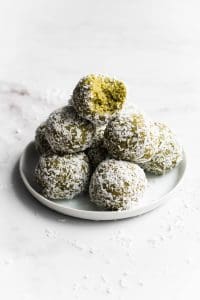In this post, we’re looking at the different types of plant-based and plant-forward diets. We’re also looking at the difference between a vegan and plant-based diet.

Are you interested in shifting to a plant-based diet? In this post, we’re looking at the different types of plant-based diets, plus answering some frequently asked questions.
There are many ways to eat a plant-based diet, each one avoiding specific foods. People choose to follow plant-based diets for many reasons, including health, environmental, ethical reasons and more. If you’re looking at shifting towards a plant-based diet, you can experiment with different ones to find a way of eating that works for you.
What Is the Difference Between Vegan and Plant-Based?
A vegan diet is a diet that includes no animal products, including meat, dairy, eggs, honey, gelatin and more. Veganism is an ethical stance against the exploitation and harm of animals. It also goes beyond food – Most people who eat a vegan diet also avoid using any animal-based products, such as cosmetics and clothes made from animals.
A plant-based diet can describe one of three things:
- It can be used as a synonym to a vegan diet.
- It can be used as a broad term to describe all types of vegetarian diets.
- Some use it to describe a way of eating that includes mostly plants and a limited amount of meat and animal products.
Everyone interprets the term plant-based differently and there’s no right or wrong answer. As a registered dietitian, I tend to use the term plant-based as a broad term to describe all types of vegetarian diets. But I also understand those who use it to describe a diet mostly based on plants. I personally love the term “plant-forward” for these types of diets.
If you want to be specific about your vegan or vegetarian diet, I recommend that you use the specific term instead of “plant-based” as it can be interpreted differently by everyone. If you don’t have a specific label that describes your vegetarian-style diet (which is okay!), you could use the term plant-based as a general description.
Can A Plant-Based Diet Help You Lose Weight?
Eating an abundance and variety of plant-based foods is associated with health benefits. However, veganism (and other plant-based diets) are not weight loss diets. When I use the term “diet” here, I mean “way of eating”, not “weight loss diet”.
Adopting a plant-based diet with the sole purpose of weight loss can make this way of eating less sustainable. Plus, it distracts from its benefits to our planet and animals.
You can eat a plant-based diet without restrictions. A vegan or vegetarian diet doesn’t need to be oil-free, sugar-free and fat-free. As a matter of fact, restricting your diet this way can lead to nutrient deficiencies and a disordered relationship with food. Check out this post to learn more about the negative effects of dieting.
And with that, let’s take a closer look at some of the most common types of plant-based diets.
Different Types of Plant-Based Diets
Lacto-Ovo Vegetarian
This is what most people think of when they think of a vegetarian diet. It excludes:
- Red meat
- Poultry
- Fish and seafood
Lacto-ovo vegetarians still eat eggs and dairy.
Ovo-Vegetarian
This is a variation of the lacto-ovo vegetarian diet that includes eggs and not dairy. It excludes:
- Red Meat
- Poultry
- Fish and seafood
- Dairy products
Lacto-Vegetarian
This is another diet similar to the lacto-ovo vegetarian diet, but it excludes eggs. It does include dairy. It excludes:
- Red Meat
- Poultry
- Fish and seafood
- Eggs
Vegan
A vegan diet excludes all animal products, such as:
- Red meat
- Poultry
- Fish and seafood
- Eggs
- Dairy
- Honey
- Gelatin and more
Veganism also goes beyond food – Most people who eat a vegan diet also avoid using any animal-based products, including leather, wool, silk and more.
Plant-Forward Diets
These diets focus mostly on plants, but include some meat and animal products.
Pescatarian
A pescatarian diet is a lacto-ovo vegetarian diet that includes fish and seafood. It excludes:
- Red Meat
- Poultry
Pollotarian
A pollotarian diet is a lacto-ovo vegetarian diet that includes poultry. It excludes:
- Red Meat
- Fish and seafood
Flexitarian (or semi-vegetarian)
This is the most flexible “plant-based” diet and can be a good starting point towards a vegan or vegetarian diet. It’s a diet that’s mostly vegetarian, but that includes occasional meat, poultry or fish and seafood. Some people decide to eat vegetarian meals at home, but will have meat or fish when eating out for convenience. Others are not ready to eat a completely vegetarian or vegan diet and will start by reducing their meat intake to a few times per week. There are no rules as to how many times per week you eat meat on a flexitarian diet. It’s simply a flexible diet that’s mostly plant-based.
What’s The Right Plant-Based Diet For You?
Only you know what type of plant-based diet is right (or not right) for you. You don’t need to switch to a vegan or vegetarian diet overnight. There’s no right or wrong way to make the switch, as long as you’re doing it in a sustainable and realistic way for you. Maybe that’s starting slowly with a flexitarian diet to see how that feels and learn from there.
Consider your preferences, motivations and knowledge. Start from a place where you feel comfortable and experiment from there. You don’t need to label your diet. Just eat in a way that works for you and that makes you feel your best, whether it fits a label or not.
In the end, 1 million people who eat one vegan meal per day will have a bigger impact than 100 people who eat a perfect vegan diet.
Looking for guidance when transitioning to a vegan or plant-based diet? Here are some posts that might help:













Leave a Reply